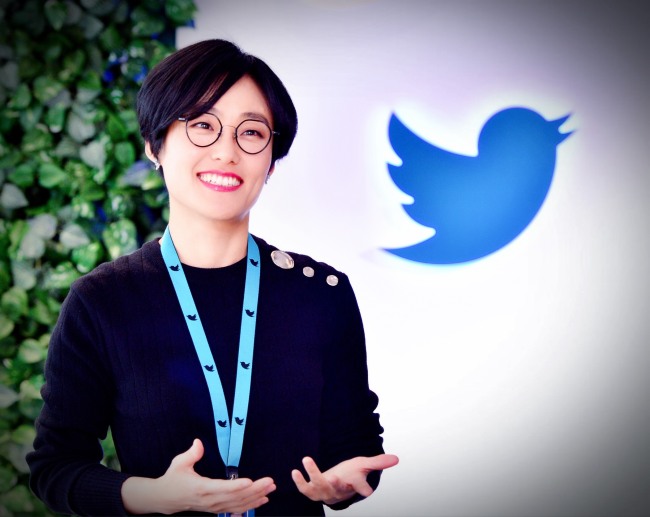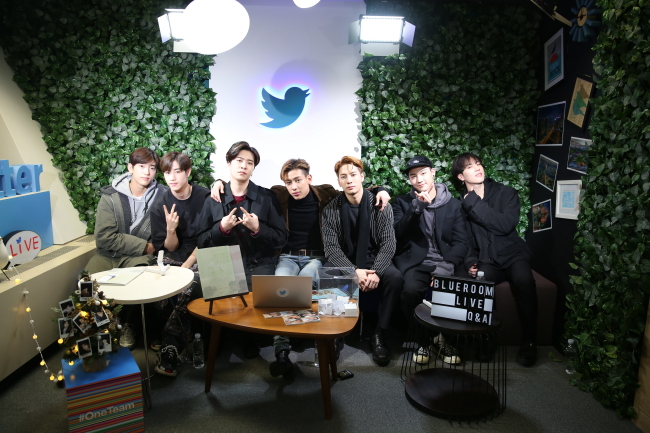While Twitter is headquartered in San Francisco, the social media giant’s K-pop capital is its office in Seoul. At the helm of the K-pop hub is Kim Yeonjeong, the head of global content partnerships at Twitter Korea.
“It’s been a while since K-pop took off in Asia, and it’s safe to say it has now expanded its reach to a wider audience worldwide -- BTS being one example,” Kim said, adding she is proud to witness the genre’s globalization.
As a Billboard charts staple, United Nations speaker and 2018’s most-tweeted-about personality, BTS has become synonymous with K-pop breaking into the mainstream.

Kim Yeonjeong, head of global content partnerships at Twitter Korea, stands inside the Blueroom studio where live broadcasts are hosted. (Park Hyun-koo/The Korea Herald)
Bang Si-hyuk, founder and executive producer of BTS’ label Big Hit Entertainment has recognized the platform’s role. He said in a keynote speech in 2017 that the traditional media’s dominant influence over the music industry had created a gap between the mainstream and the nonmainstream artists in K-pop -- which social media like Twitter helped bridge.
The Big Hit chief said exposure on the digital outlet was a game changer.
“BTS is actively in touch with fans through social media, drawing spotlight in the process from those previously unacquainted with the group, and eventually from the established media,” he said.
And fandom-wise, Twitter seems to be the preferred destination. Twitter Korea’s year-end statistics show fandoms ruled the timeline in 2018, with the top 10 most tweeted about people on the medium all being K-pop stars.
“If other social media channels are a ‘look at me’ kind of platform, Twitter is a ‘look at this’ kind,” she said. “Interaction (on Twitter) centers around what you’re interested in, as opposed to who you are.”
Twitter’s role is simply to provide a free and open conversation forum, according to Kim.
“What the global content partnerships team does is fuel user engagement and allow real-time, content-rich dialogue to take place,” she said.
Leveling the playing field “What’s great (about Twitter) is that it acts as a substitute for, or even a better alternative to, the established broadcast networks. It provides an opportunity for exposure, which used to be a luxury for a lot of artists at small or medium-sized labels,” Kim said.
“K-pop is a highly saturated market, and if you aren’t from one of the brand name labels, it’s easy to get overshadowed. And it’s a gap that can be filled here (on Twitter).”

Kim Yeonjeong, head of global content partnerships at Twitter Korea (Park Hyun-koo/The Korea Herald)
A kind of a meritocracy is achieved in the Twitterverse, Kim went on, which serves as “a level playing field for heavyweights and underdogs alike.”
Kim views Twitter as “an open stage where everyone is given a voice.” “How engaging of a conversation they can bring about is up to them,” she added.
BTS is a forerunner in leveraging that online exposure.
The superstar group grew from humble beginnings, at a small, nascent label. Before BTS emerged, making a name in the K-pop scene generally meant debuting under one of the “Big Three”: S.M. Entertainment, JYP Entertainment or YG Entertainment. Megahits such as BTS outside that realm were an anomaly -- almost an impossibility.
Kim said the septet was “years ahead (of other groups)” in its engagement on Twitter, giving the audience an open and direct access to its content and creating a two-way forum for communication. Her point coincides with the group’s producer Bang’s, in that BTS earned exposure on the digital sphere that was not traditionally granted to artists with nonmainstream roots.
The K-pop sensation won Billboard’s top social artist award for two consecutive years in 2017 and 2018, dethroning Justin Bieber. And Kim was right there in Las Vegas in May 2018 to witness the crowning moment at the Billboard Music Awards, which she said was “one of the most unforgettable events” from last year as Twitter’s K-pop director.
“When RM gave the famous ‘what social means for us’ speech, it inspired in me a renewed aspiration to help more K-pop artists reach the global stage, through the power of the platform that Twitter has,” she said. “Billboard wouldn’t celebrate Social 50 if it didn’t think (social media influence) mattered.”
Future hit barometer
According to Kim, Twitter trends sometimes precede real-life trends, sniffing out “the next big hit.”
Referring to BTS as an example, she said one striking thing not to be overlooked about the group’s rise to superstardom is that it was a hit overseas before it was big at home in Korea.
“Before (BTS), things were almost always the other way around,” she said, explaining that the reverse trend attests to the fact that “quality doesn’t go unnoticed, once it’s open for access.” “We just want to provide the space where accessibility isn’t inhibited and interaction is maximized,” she said.
She added that Twitter influence doesn’t immediately translate to the star power perceived offline. “But we find that once you start getting noticed on the platform, you eventually get noticed elsewhere.”
One measure of Twitter influence is how much derivative content is created by users from an original post.
“For instance, one selfie posted by a Twitter celebrity is infinitely reproduced by fans as retweets, memes and other fan-made content,” she said. “Influence is when you dictate and drive the conversation. When one post is followed up by a constant influx of additional input from other users, we call that influential.”
This ability to attract engagement and gain a following acts as one aspect of assessing a Twitter presence, Kim said, and those numbers can foreshadow future hits.
When asked to name some of the more impressive newcomers, Kim singled out Stray Kids among others, whom she met at a live event held at Twitter Korea’s headquarters when they had just debuted. “For a newly debuted act, the response from fans worldwide was incredible,” she recounted.
When the latest boy band from JYP Entertainment snagged the New Artist of the Year title at the Mnet Asian Music Awards in December, Kim said she thought to herself she must have been right in thinking the rookie group had huge potential.
Minus strategy
One of Twitter’s flagship programs that Kim orchestrates as the mastermind behind the K-pop division is the in-studio live broadcast series Blueroom.
Conversation on the web consists of more than just blocks of text, and Blueroom is among recently introduced features in the initially text-oriented outlet as a way of enlivening conversations. Launched in 2017, the studio invites celebrities from varying sectors such as entertainment, culture and politics.
In 2018, Kim organized 34 Blueroom live broadcasts, and met over 200 artists in person.
Asked to share memorable moments from past shows, she agonized trying to pick just a few.

GOT7 sits in the Blueroom studio at Twitter Korea headquarters on Dec. 5, 2018. (Twitter Korea)
“The one with GOT7 on Dec. 4 was particularly impressive on many levels, both personally and also numbers-wise,” Kim said. “It generated a massive response: 4 million tweets and 1.5 million views. And as it was (GOT7’s) first visit to Blueroom in three years, I was proud to witness how much the group has grown over the years.”
The septet’s approach to work also aligns with that pursued by Blueroom.
“(The GOT7 bandmates) are at ease and they work like they’re at play, without forgoing professionalism or work ethic,” Kim said.
“Less is more” is Twitter’s mantra when it comes to its own brand of broadcasts. “We call it ‘the minus strategy,’” Kim explained. “The Blueroom doesn’t have a format. It’s anti-structure. That way we keep the chat genuine, less affected, casual.”
She said the strategy works wonders in unveiling a performer’s offstage persona, and is another way Twitter differentiates itself from traditional media.
“You see the deliberately staged kind all the time on television,” she said. “(On Blueroom) we unveil the artist’s more personable side -- even some artists who tend to be shrouded in mystery -- and elicit a more freewheeling kind of conversation.”
“Remember, this isn’t like a television broadcast,” she reminds artists ahead of each broadcast.
“We just let them be -- have fun -- and everything just clicks naturally.”
By Kim Arin (
arin@heraldcorp.com)





![[Herald Interview] 'Amid aging population, Korea to invite more young professionals from overseas'](http://res.heraldm.com/phpwas/restmb_idxmake.php?idx=645&simg=/content/image/2024/04/24/20240424050844_0.jpg&u=20240424200058)


